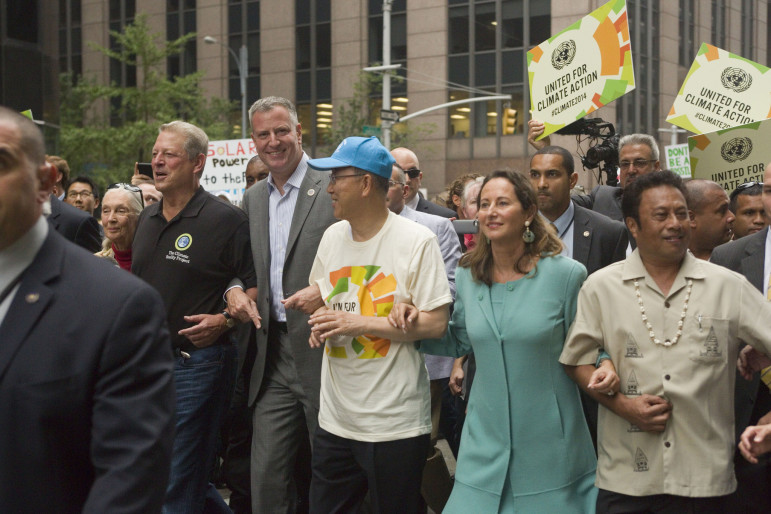
Ed Reed/Mayoral Photography Office.
Mayor de Blasio, with former VP Al Gore to his right, walks in the 2014 climate march.
With the doomsday clock for climate change rapidly ticking, Earth Day this year is more urgent than ever.
While the main focus in New York City on Earth Day will be the more than 100 countries formally signing on the climate change agreement made in Paris, Mayor de Blasio will also make a major Earth Day announcement – hopefully one that spurs the development of offshore wind.
There are many things to fault about the COP21 agreement. The “voluntary” pledges announced by individual countries to date won’t even limit global warming to 3.5 degrees Celsius, let alone the 1.5 degrees target that the 100-plus developing nations got the industrial countries to agree to. The industrial nations also failed in Paris to commit real funds to help the third world deal with the impacts of climate change caused by the industrial nation.
World leaders, however, did finally publicly declare in Paris that the era of fossil fuels needed to end. Climate deniers are officially a fringe crackpot group, even in the U.S. – with the notable exception of the Republican presidential candidates and Congress. A record number of nations—more than 130, including 60 national leaders – will be at the UN for the Earth Day signing ceremony. Secretary of State Kerry will represent the U.S.

No Backspace is City Limits' new blog featuring a recurring cast of opinion writers passionate about New York people, policies and politics. Click here to read more..
Some thought de Blasio would use Earth Day to finally announce an agreement to impose a fee on plastic bag use, a campaign started more than three years ago – an issue that Mayor Bloomberg pushed but failed to win. However, this week Councilmembers Landers and Chin announced they had obtained majority support for a revised 5-cent bag fee and hope to pass the bill on April 20. The plastic bag industry is making one last run to stop it.
Offshore wind (OSW) has emerged as the central litmus test for climate change advocates in New York. Even the governor’s energy czar recently admitted that there was no way for the Cuomo administration to meet Gov. Cuomo’s 2030 climate change goals – limited as they may be—without having a major offshore wind program. Fortunately, the gold mine for offshore wind is off of the Rockaways and Eastern Long Island, identified as the number one priority for the federal government.
Unlike Europe and China, OSW hasn’t taken off yet in the U.S. because politicians still want to rely on “market forces” to drive its development. The state’s own study, however, said that the only way to drive down the costs of OSW is to make a big enough commitment to purchase OSW electricity to cut costs by 30 percent. Climate activists are pushing the governor to over rule his energy czar and commit to purchasing 5,000 MW of OSW by 2025.
Activists also want de Blasio to step up to the plate and make a commitment to purchase at least some OSW. The mayor has been applauded for setting a goal to purchase 100 percent of the city’s own electricity from new renewables. Only 2 percent of the $650 million spent by the city for electricity presently comes from renewable. While the mayor has made positive statements about OSW, he has yet to sign on the dotted line to buy it.
Investing in OSW would create tens of thousands of jobs while reducing the negative health impacts from burning fossil fuels. The resulting air pollution leads to an estimated 3,000 plus excess deaths in the state annually (mainly in the state).
Climate advocates also want the mayor on Earth Day to commit the city to meeting its overall energy demand – including transportation and buildings – with 100 percent clean energy as soon as possible (preferably by 2030). An increasing number of cities have adopted such goals, including San Diego, which recently set a goal of 100 percent clean energy by 2035.
Buildings account for 75 percent of the city’s carbon footprint. The effort started under Bloomberg to have large buildings voluntary undertake cost-effective energy retrofits has been unsuccessful. Advocates and the Council’s Progressive Caucus feel it is time for the city to mandate such retrofits.
The New York City Environmental Justice Alliance recently issued a report faulting the mayor for failing to follow through on his commitment to equity for low-income and communities of color in OneNYC, de Blasio’s version of the city’s plan for sustainability started by Bloomberg. They pointed out that the city is not doing enough to protect vulnerable communities from the dangers of climate change, instead investing public funds for resiliency protections in more affluent neighborhoods. And when environmental investments are made in such neighborhoods, too often it is part of the process of gentrification.
Advocates want the mayor or the City Council to convert OneNYC into a detailed climate action plan, with timelines and benchmarks to guide the city’s action.
The City Council has also been pushing the mayor, passing legislation to promote the solarization (or energy retrofitting) of all public buildings, though initially only studies are required. Advocates also hope the city will invest in the infrastructure (e.g., recharging stations) needed to move to electric vehicles.
Advocates hope the mayor will support the expansion of community and public ownership of energy systems, such as community-shared renewables. Many are worried that low- and moderate- income residents will not be able to participate in the transition to renewables.
Finally, advocates urge the Mayor to empower city residents to participate in the development of the city’s climate action plans. While the mayor argues otherwise, community groups say they were excluded from the development of OneNYC. They want de Blasio to fulfill his pledge to build a transparent, inclusive government.








